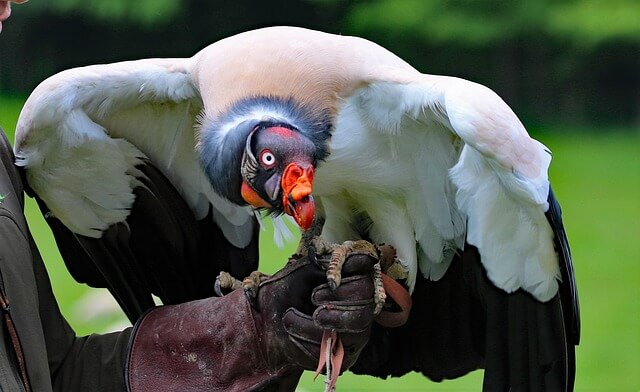California Condor (Gymnogyps californianus) is the largest flying bird in the world. Unlike most Falconiformes, the male of the California Condors is slightly larger than the female.
Previously, Condors were quite common on the Pacific coast of North America. Today their number has decreased to a dozen. There are no breeding pairs left in nature, and the population is supported only by the release of birds previously held in captivity.
The Condor is a scavenger, feeds mainly on the corpses of large animals. Sometimes it can attack a lamb or a sick sheep. These birds can soar in the air for a long time, looking for food. The color of the condors is mainly black.
They nest in caves, rocks, hollows of trees. There is only 1 egg in the clutch. The Condors breed once every two years. A condor chick can fly only when it is one year old. Therefore the species is listed in the Red Book.
1. Andean Condor is the biggest flying bird in the world. Condors belong to the family of American vultures.
2. The Condor is a bird whose wingspan reaches 10 feet and even more.
3. This huge bird lives along the entire coast of the Pacific Ocean of South America, of course, including the Andes. The southern boundary of the range is located on Tierra del Fuego, and the northern – on the territory of Colombia and Venezuela.
You can meet these majestic birds high in the mountains and in the foothills, in the plains
5. In addition to the Andean condor, there is a very rare species the California Condor, which is smaller in size.
6. This type of Condor lives in the mountains of California, Arizona, Utah and Mexico. And earlier the Californian condor used to live on the entire North American continent.
7. Its wingspan reaches 10 feet. The body length reaches 49 inches, weight does not exceed 31 pounds.
8. The Californian Condor is black-feathered with white feathers on its belly and a black collar with sharp feathers on its neck, which stick out in different directions. Beak is short and strong.
9. The body length of adult Andean condors ranges from 46 to 53 inches. Wingspan is about 122 inches on average.
The male Andean condor weighs from 24 to 33 pounds, its females weigh less: from 17 to 24 pounds
11. This bird almost disappeared in the 20th century, but since the 1980s a special program to restore this species has been carried out at the San Diego Zoo.
12. The Europeans first saw the Andean condor in 1553, and Cieza de Leon described it in the book The Chronicle of Peru (Crónica del Perú).
13. The name of the condor species comes from the Quechua language, where the word “kúntur” means this bird, as well as a fast and great traveler.
14. Travelers have already noted that these birds are capable of rising to the great height of the Andes – about 4 miles above sea level, where their presence is almost the only sign of life.
15. The plumage of the condor is contrasting and expressive. Almost the entire bird is black, except for a white fluffy collar around the neck and wide white edges on the wings, which are especially pronounced in males.
16. The head and throat of the condor are not feathered, the skin in these places is pale pink or reddish-purple, sometimes brown. When a bird is excited, these areas of skin change their color to yellow or red, which is a warning signal for other individuals. Taking care of themselves, the birds themselves thoroughly clean their heads from feathers.
The young birds have a greyish brown color with dark, almost black skin on the head and neck, and a brown collar
18. The head of the condor is a little flattened on top. Males have a large fleshy crest in a dark red color, the skin on the neck is wrinkled and forms the so-called “earrings”.
19. The beak is long, strong, curved at the tip, black with a yellow top. The male iris is brown, and female one is bright red.
20. Its feet are dark gray, claws are straight, not sharp. The structure of the legs of the condor does not allow the bird to hold and transfer the prey, so they have to eat it in the same place where they find it.









This photo is a King Vulture, not a condor